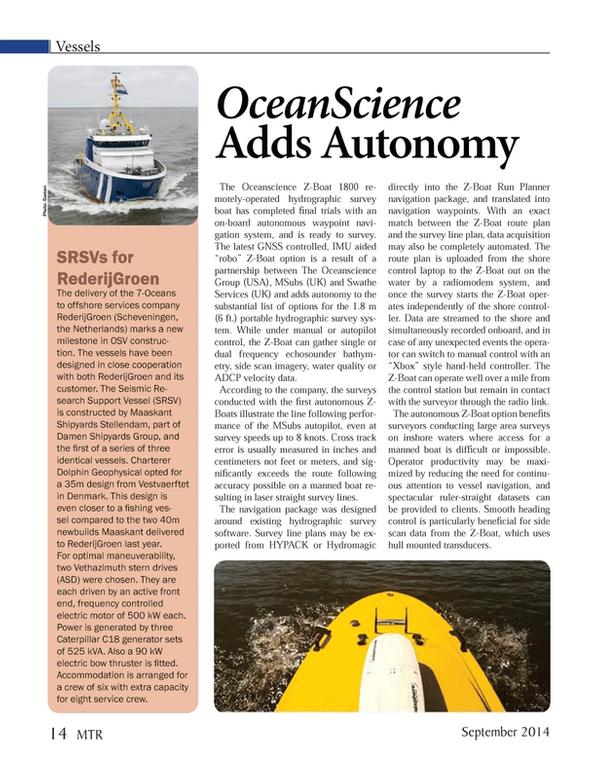
OceanScience Adds Autonomy
The Oceanscience Z-Boat 1800 remotely-operated hydrographic survey boat has completed final trials with an on-board autonomous waypoint navigation system, and is ready to survey. The latest GNSS controlled, IMU aided “robo” Z-Boat option is a result of a partnership between The Oceanscience Group (USA), MSubs (UK) and Swathe Services (UK) and adds autonomy to the substantial list of options for the 1.8 m (6 ft.) portable hydrographic survey system. While under manual or autopilot control, the Z-Boat can gather single or dual frequency echosounder bathymetry, side scan imagery, water quality or ADCP velocity data.
According to the company, the surveys conducted with the first autonomous Z-Boats illustrate the line following performance of the MSubs autopilot, even at survey speeds up to 8 knots. Cross track error is usually measured in inches and centimeters not feet or meters, and significantly exceeds the route following accuracy possible on a manned boat resulting in laser straight survey lines.
The navigation package was designed around existing hydrographic survey software. Survey line plans may be exported from HYPACK or Hydromagic directly into the Z-Boat Run Planner navigation package, and translated into navigation waypoints. With an exact match between the Z-Boat route plan and the survey line plan, data acquisition may also be completely automated. The route plan is uploaded from the shore control laptop to the Z-Boat out on the water by a radiomodem system, and once the survey starts the Z-Boat operates independently of the shore controller. Data are streamed to the shore and simultaneously recorded onboard, and in case of any unexpected events the operator can switch to manual control with an “Xbox” style hand-held controller. The Z-Boat can operate well over a mile from the control station but remain in contact with the surveyor through the radio link.
The autonomous Z-Boat option benefits surveyors conducting large area surveys on inshore waters where access for a manned boat is difficult or impossible. Operator productivity may be maximized by reducing the need for continuous attention to vessel navigation, and spectacular ruler-straight datasets can be provided to clients. Smooth heading control is particularly beneficial for side scan data from the Z-Boat, which uses hull mounted transducers.
(As published in the September 2014 edition of Marine Technology Reporter - http://www.marinetechnologynews.com/Magazine)
Read OceanScience Adds Autonomy in Pdf, Flash or Html5 edition of September 2014 Marine Technology
Other stories from September 2014 issue
Content
- ULSTEIN PX121 for Otto Offshore page: 10
- Triton Submarines’ New Submersible page: 12
- OceanScience Adds Autonomy page: 14
- Island Performer for Deep-Sea Subsea Work page: 16
- Rogue Waves page: 18
- The Blue Economy page: 20
- Innovative Solutions Mark SWE’s Heritage page: 24
- Multi-channel Fiber Optic System Design: Going Big in Small Packages page: 28
- Wave Glider – Ocean Monitoring in Motion page: 36
- Underwater Noise Understood: Clear to Hear page: 46
- Wachs Subsea Answers the Call for Chevron page: 52
- Biofouling Foiled: UV Light Harnessed for Biofouling Control page: 58
- New Subsea Hi-Traq Trencher page: 74
- Kongsberg Upgrades Digital Stills Camera page: 75
- Thien Nam Buys Sonardyne’s Ranger 2 page: 75
- MTR 100: ASV page: 91


